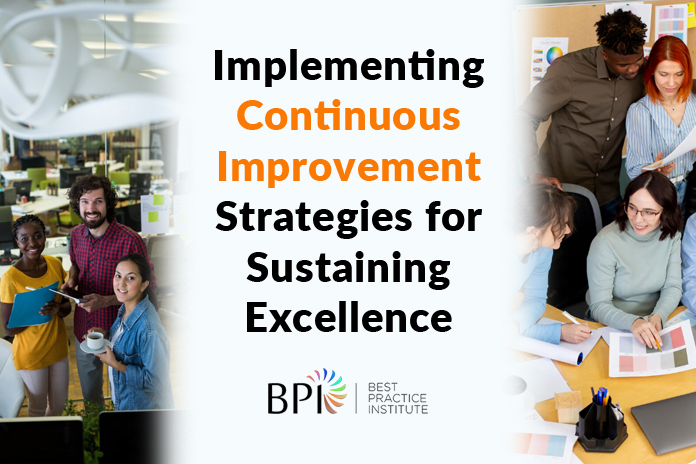5 min. Read
Organizations today must continuously strive for excellence to stay competitive. Implementing continuous improvement strategies is crucial for achieving and sustaining excellence. These strategies focus on enhancing processes, optimizing performance, and fostering innovation and growth. Let’s explore some key strategies for implementing continuous improvement and sustaining excellence in the workplace.
1. Embrace a Culture of Continuous Improvement
To sustain excellence, organizations must cultivate a culture that values continuous improvement. It involves encouraging employees at all levels to identify areas for improvement, experiment with new ideas, and learn from successes and failures. Leaders are crucial in promoting this culture by recognizing and rewarding innovative thinking and supporting employees’ efforts to improve processes.
Encouraging Employee Engagement
Encouraging employees to participate in the improvement process actively fosters a sense of ownership and commitment. Organizations can create feedback loops, hold regular improvement meetings, and recognize and reward employees for their contributions.
Providing Resources and Support
To sustain a culture of continuous improvement, organizations must provide employees with the necessary resources and support. It includes training programs, access to tools and technologies, and leadership support to implement their ideas effectively.
Learning from Failures
Failure is an inevitable part of the improvement process. Organizations should encourage a culture where failures are seen as learning opportunities rather than setbacks. By analyzing failures and understanding the root causes, organizations can make informed decisions to prevent similar issues in the future.
2. Utilize Lean and Six Sigma Principles
Lean and Six Sigma are methodologies that can help organizations streamline processes, reduce waste, and improve quality. By implementing these principles, organizations can identify inefficiencies, eliminate bottlenecks, and enhance operational efficiency. Training employees in Lean and Six Sigma principles can also empower them to contribute to continuous improvement efforts.
Value Stream Mapping
It is a Lean technique used to visualize and analyze the steps in delivering a product or service. By mapping out the value stream, organizations can identify wasteful and inefficient areas and develop strategies to eliminate them.
Kaizen Events
Kaizen is central to the Lean methodology. Kaizen events are focused, short-term projects aimed at improving a specific process. These events bring together cross-functional teams to brainstorm ideas, implement changes, and measure the results.
Six Sigma DMAIC Methodology
The DMAIC methodology is a critical component of Six Sigma. This structured approach helps organizations identify the root causes of problems, implement solutions, and ensure that improvements are sustained over time.
3. Implement Agile Practices
Initially developed for software development, Agile methodologies can apply to various aspects of business operations. Agile practices emphasize iterative development, collaboration, and adaptability. By adopting agile practices, organizations can respond more effectively to changing market conditions, improve decision-making, and enhance customer satisfaction.
Iterative Development
Agile practices emphasize iterative development, where work is broken down into small, manageable tasks completed in short time frames called sprints. It allows teams to quickly adjust to changing requirements and deliver value to customers more frequently.
Cross-Functional Collaboration
Agile encourages cross-functional collaboration, where individuals from different disciplines work together towards a common goal. This collaboration promotes knowledge sharing, creativity, and innovation, improving outcomes.
Embrace Change
One of the core principles of Agile is embracing change. Agile organizations can quickly respond to market changes, customer feedback, and internal opportunities by continuously reviewing and adapting their processes.
4. Encourage Employee Involvement and Empowerment

Employees are often the best source of ideas for process improvement. Organizations should actively involve employees in identifying opportunities for improvement and implementing solutions. Empowering people to make decisions and take ownership of improvement initiatives can increase their engagement and motivation, leading to sustained excellence.
Open Communication Channels
It is vital to have open communication channels where people feel comfortable sharing their ideas and concerns. It can include suggestion boxes, team meetings, or digital idea-sharing platforms. Organizations can harness valuable insights for improvement by actively listening to employee feedback.
Empowerment Through Training and Development
Investing in employee training and development empowers individuals to contribute meaningfully to continuous improvement efforts. By providing relevant skills and knowledge, organizations equip employees with the tools to identify opportunities, propose solutions, and drive positive change.
Recognize and Celebrate Successes
Acknowledging and celebrating successes, big or small, is crucial for maintaining momentum and morale. Recognizing employees for their contributions to continuous improvement reinforces a culture of innovation and encourages ongoing engagement.
5. Utilize Technology for Continuous Improvement
Technology plays a vital role in enabling continuous improvement. Organizations can leverage data analytics, automation, and digital tools to gather insights, monitor performance, and identify areas for improvement. By harnessing technology, organizations can accelerate their improvement efforts and drive sustainable excellence.
Data Analytics for Insights
Data analytics tools can provide organizations with valuable insights into their processes, performance, and areas for improvement. Organizations can decide and prioritize improvement initiatives by analyzing data trends and patterns.
Automation for Efficiency
Automation technologies streamline repetitive tasks, reduce manual errors, and increase efficiency. By automating routine processes, organizations save time and resources to reallocate to more strategic initiatives or innovation projects.
Digital Collaboration Tools
Digital collaboration tools facilitate communication and collaboration among remote or distributed teams. These tools enable real-time sharing of information, brainstorming sessions, and project management, enhancing productivity and fostering a culture of continuous improvement.
6. Establish Key Performance Indicators (KPIs)
Organizations should establish clear KPIs that align with their strategic goals to measure the effectiveness of continuous improvement efforts. These KPIs should be regularly monitored to track progress, identify trends, and make data-driven decisions. By focusing on measurable outcomes, organizations can ensure that their improvement efforts are making a meaningful impact.
Final Word
Implementing continuous improvement strategies is essential for sustaining excellence in today’s dynamic business environment. Organizations can drive constant growth and achieve sustained excellence through a culture of continuous improvement, leveraging proven methodologies, empowering employees, embracing technology, and setting clear KPIs.
Best Practice Institute (BPI) offers valuable resources and expertise to support organizations toward continuous improvement and workplace excellence. Contact us today to learn more about how we can help you achieve your goals.










